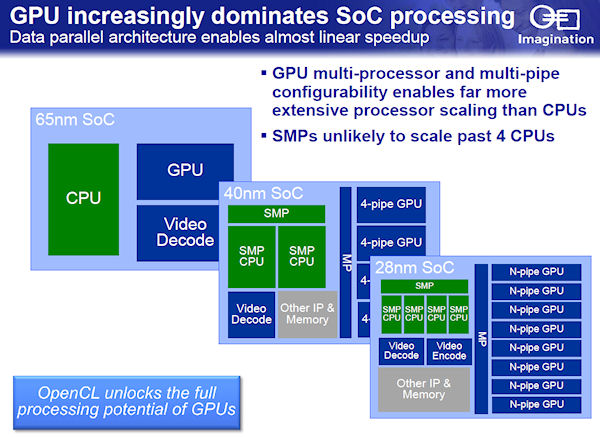Going Rogue
It was never my intention to dwell exclusively on Apple, and as we moved on to the broader environment in which Imagination operates, we reflected on the platforms Imagination supports through its other partners, most notably Texas Instruments.
"Android is brilliant for us because it caused the smartphone to become commoditised quicker, whereas Windows Phone 7 brings a very different ecosystem," said King-Smith.
While TI is suffering a bit due to the decline of its major OEM partner Nokia, it has managed some good wins with the likes of BlackBerry and LG. "The performance of the PlayBook [TI OMAP 4430] really impressed us," said King-Smith "The QNX graphics team is one of the best we've worked with."
And he was keen to point out that some of Imagination's less well-known partners - such as ST Ericsson (on which more in a bit), Renesas and Mediatek - are all flourishing.

Furthermore, Imagination is not just about GPUs. "We're the world's biggest supplier of embedded video, and we're years ahead of everyone else with our Ensigma universal comms engine." Ensigma is a tiny chip that can receive a wide range of broadcast frequencies, as well as Wi-Fi, and dynamically switch between them. It may even be the case that Qualcomm's acquisition of Atheros may well have been done with this chip in mind, at least in part.
To conclude I steered the conversation onto Rogue - the next generation of PowerVR GPUs. "You'll see quite a few devices coming out in the next year using that technology," said King-Smith. "Rogue creates the ability to intercept high-end graphics."
In order to substantiate both these claims, King-Smith pointed to the launch of the Nova A9600 by ST Ericsson, which will feature two ARM Cortex A15 cores and a Rogue GPU delivering in excess of 210 GFLOPS - a measure of raw processing power.
To put that into context, check out this HEXUS GPU table. It features, among others, the NVIDIA GeForce GTX480, which provides 1,345 GFLOPS. While the Nova chip can only manage 15 percent of the processing power of this mid-range desktop GPU, it should be noted that the GTX480 requires 250W of power, while embedded GPUs need to operate at under a watt.
So King-Smith is understandably excited about what the future holds for Imagination, not just because Apple is doing so well, but because embedded graphics is moving to centre-stage in general. This is due partly to the amount of gaming now done on mobile devices, and the volume of video now viewed on them, but also the amount of more general processing the GPU is now able to do.
"We're at the dawn - at last - of the era of parallel computing. Augmented reality is a good starting point, but we're also seeing video pre and post-processing, as well as moving physics onto the GPU," said King-Smith. "It makes no sense to put the heavy lifting applications on the CPU - the CPU is the brain, but the GPU is the brawn."
We'll leave you with one last slide from Imagination, illustrating this point, and a video clip from GPU computing software specialist AccelerEyes, showing some of the clever stuff you can do with PowerVR GPUs these days.














